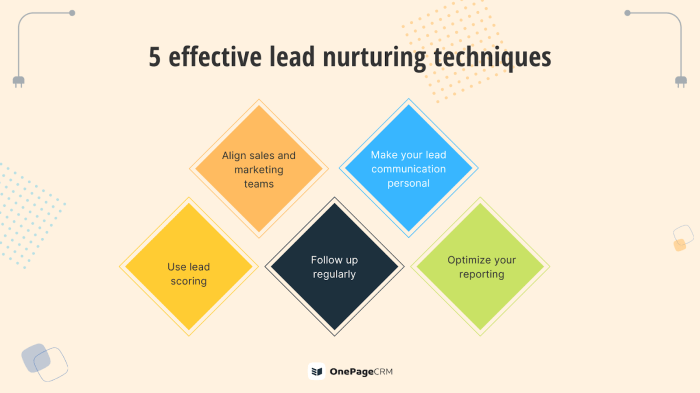Lead Nurturing Techniques are the key to unlocking successful customer relationships. From personalized content to automated approaches, dive into the world of nurturing leads like a pro.
Learn the strategies, best practices, and metrics that drive businesses to nurture leads effectively and boost conversions.
Overview of Lead Nurturing Techniques
Lead nurturing in the context of marketing involves building relationships with potential customers at every stage of the buyer’s journey. It focuses on understanding the needs of prospects and providing them with relevant information to move them closer to making a purchase.
Lead nurturing is crucial for businesses as it helps in increasing conversion rates, building brand loyalty, and ultimately driving revenue growth. By staying engaged with leads over time and delivering valuable content, businesses can establish trust and credibility, making it more likely for leads to choose their products or services.
Successful lead nurturing campaigns often involve personalized communication, targeted content based on the lead’s interests and behavior, and consistent follow-up. For example, sending out tailored email sequences, offering exclusive deals or discounts, or providing educational webinars can all be effective strategies to nurture leads.
Lead nurturing differs from lead generation in that lead generation focuses on capturing the interest of potential customers and getting them into the sales funnel, while lead nurturing focuses on building relationships with those leads and guiding them towards a purchase decision. It’s about cultivating long-term relationships with leads rather than just generating initial interest.
Types of Lead Nurturing Techniques

Lead nurturing is crucial for converting leads into customers, and there are various techniques businesses can utilize to achieve this goal. Let’s explore some of the key types of lead nurturing techniques below.
Email Campaigns
Email campaigns involve sending targeted emails to leads at different stages of the sales funnel. These emails can provide valuable information, promotions, or personalized content to keep leads engaged and interested in the products or services.
Content Marketing
Content marketing focuses on creating and sharing valuable content, such as blog posts, whitepapers, or videos, to attract and educate leads. By providing relevant and useful information, businesses can establish trust with leads and nurture them towards making a purchase decision.
Social Media Engagement
Social media platforms offer a great opportunity for businesses to engage with leads on a more personal level. By sharing content, responding to comments, and participating in conversations, businesses can build relationships with leads and guide them through the sales process.
Personalized Content, Lead Nurturing Techniques
Personalized content plays a significant role in lead nurturing by tailoring the messaging and offers to the specific needs and interests of each lead. By delivering personalized content, businesses can increase engagement, build trust, and ultimately drive conversions.
Automated vs. Manual Lead Nurturing
Automated lead nurturing involves using software to send targeted messages to leads based on their behavior and interactions with the business. This approach allows for scalability and efficiency in nurturing a large number of leads simultaneously. On the other hand, manual lead nurturing involves personalized communication with leads, which can be more time-consuming but allows for a more human touch and deeper relationship building.
Best Practices in Lead Nurturing

To create effective lead nurturing strategies, it is crucial to personalize communication with leads, provide valuable content, and maintain consistent follow-ups to build trust and credibility. Segmentation plays a vital role in lead nurturing by allowing marketers to tailor messages according to the specific needs and interests of different segments of leads.
Tips for Creating Effective Lead Nurturing Strategies
- Personalize communication based on lead behavior and preferences.
- Provide valuable and relevant content that addresses the pain points of leads.
- Establish a consistent follow-up schedule to stay top-of-mind with leads.
Significance of Segmentation in Lead Nurturing
Segmentation enables marketers to send targeted messages to specific groups of leads, increasing relevance and engagement. By dividing leads based on demographics, behaviors, or interests, companies can deliver personalized content that resonates with each segment.
Examples of Successful Lead Nurturing Emails or Messages
An example of a successful lead nurturing email is one that offers a free resource related to the lead’s previous interactions with the company. By providing value and addressing the lead’s specific needs, the email can help move the lead further down the sales funnel.
Role of CRM Systems in Optimizing Lead Nurturing Efforts
CRM systems play a crucial role in optimizing lead nurturing efforts by centralizing lead information, tracking interactions, and automating personalized communication. With CRM systems, marketers can efficiently manage leads, analyze data to improve strategies, and ensure timely follow-ups for better conversion rates.
Metrics and KPIs for Evaluating Lead Nurturing Success
Lead nurturing success can be measured through various key performance indicators (KPIs) that provide insights into the effectiveness of your campaigns. Analyzing conversion rates, tracking engagement metrics, and using the right tools are essential components of evaluating lead nurturing success.
Conversion Rates Analysis
- Conversion rates indicate the percentage of leads that progress through the sales funnel and take the desired action.
- Analyze conversion rates at different stages of the nurturing process to identify areas for improvement.
- Compare conversion rates between different campaigns or segments to determine the most successful strategies.
Importance of Tracking Engagement Metrics
- Engagement metrics measure how leads interact with your content and respond to your nurturing efforts.
- Tracking metrics like email open rates, click-through rates, and time spent on website can indicate the level of interest and engagement.
- Engagement metrics help you tailor your nurturing strategies to better resonate with your leads and improve overall effectiveness.
Tools for Monitoring Lead Nurturing Performance
- Customer Relationship Management (CRM) software like Salesforce or HubSpot can track lead interactions and provide insights for optimization.
- Marketing automation platforms such as Marketo or Pardot help automate lead nurturing processes and analyze performance metrics.
- Analytics tools like Google Analytics offer valuable data on website traffic, conversions, and user behavior to evaluate the impact of lead nurturing efforts.
